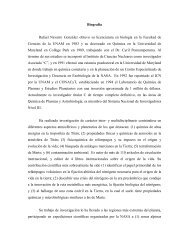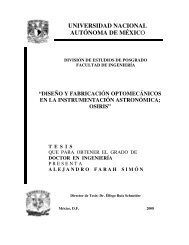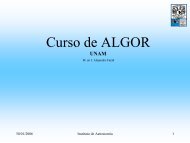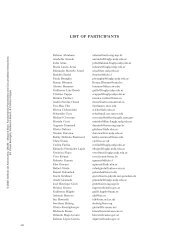Untitled - Instituto de Astronomía - UNAM
Untitled - Instituto de Astronomía - UNAM
Untitled - Instituto de Astronomía - UNAM
You also want an ePaper? Increase the reach of your titles
YUMPU automatically turns print PDFs into web optimized ePapers that Google loves.
momento ningún estudio parece mostrar evi<strong>de</strong>ncia <strong>de</strong> niveles <strong>de</strong><br />
toxicidad para las células. En el lado <strong>de</strong> las <strong>de</strong>sventajas existe una<br />
problemática no <strong>de</strong>l todo resuelta: la estabilidad termodinámica<br />
<strong>de</strong> las proteínas. Los trabajos <strong>de</strong> Tsien mostraron que la actividad<br />
fluorescente está asociada principalmente al hecho <strong>de</strong> que el grupo<br />
cromóforo se halla “blindado” por las once hebras beta que forman<br />
el barril <strong>de</strong> GFP y que es típica <strong>de</strong> las proteínas fluorescentes. Al<br />
<strong>de</strong>snaturalizarse, sin embargo, el grupo cromóforo queda expuesta a<br />
las enzimas <strong>de</strong>l medio celular, perdiéndose todo rastro <strong>de</strong> la actividad<br />
fluorescente. Es entonces <strong>de</strong> crucial importancia generar mutantes<br />
que al mismo tiempo <strong>de</strong> ser fluorescentes sean lo suficientemente<br />
robustas para evitar la <strong>de</strong>snaturalización en condiciones aún más<br />
extremas <strong>de</strong> pH y temperatura.<br />
Las implicaciones biomédicas en el tratamiento <strong>de</strong> muchos<br />
pa<strong>de</strong>cimientos hoy intratables son fascinantes. Estudios recientes <strong>de</strong>l<br />
pa<strong>de</strong>cimiento <strong>de</strong> Alzheimer i<strong>de</strong>ntifican como un factor importante<br />
Referencias<br />
[1] Editorial and Primer. Nature Methods 8 (1), 25-25, (2011).<br />
[2] Zhang F, Wang LP, Boy<strong>de</strong>n ES and Deisseroth K. Nature Methods 3, 785, (2006).<br />
[3] Deisseroth K. Nature Methods 8, 26, (2011).<br />
[4] Arrenberg AB, Stainier DYR, Baier H and Huisken J. Science 330, 971, (2010)<br />
[5] The Nobel Prize in Chemistry 2008. http://nobelprize.org<br />
[6] Chudakov D M, Matz M V, Lukyanov S and Lukyanov K. A. Physiol Rev 90, 1103, (2010).<br />
• 6 •<br />
• las gran<strong>de</strong>s preguntas <strong>de</strong> la física<br />
para la <strong>de</strong>sincronización neuronal al<br />
flujo irregular <strong>de</strong> iones <strong>de</strong> Ca+2. Las<br />
proteínas <strong>de</strong>l tipo Channelrhodopsin-2<br />
y NpHR podrían ser los precursores<br />
<strong>de</strong>l tratamiento optogénetico futuro<br />
<strong>de</strong> éste y otros pa<strong>de</strong>cimientos al po<strong>de</strong>r<br />
ser controlados eventualmente con<br />
tal precisión que ciertos grupos <strong>de</strong><br />
neuronas podrían ser silenciadas en<br />
tanto que otras podrían ser activadas<br />
con patrones específicos <strong>de</strong> luz. Por<br />
otro lado, patologías como taquicardias<br />
y bradicardias están también en el<br />
horizonte no lejano. Las siguientes<br />
décadas seguramente verán la explosión<br />
<strong>de</strong> estas técnicas hoy todavía en el<br />
laboratorio.<br />
[7] Chalfie M, Tu Y, Euskirchen G, Ward W W. Science 263, 5148, (1994).<br />
[8] Tsien R. Angew Chem Int Ed 48, 5612, (2009)<br />
[9] Livet J, Weismann T A, Kang H, Draft R W, Lu J, Bennis R A, Sanes J R and Lichtman J W. Nature 450, 56, 2007.










